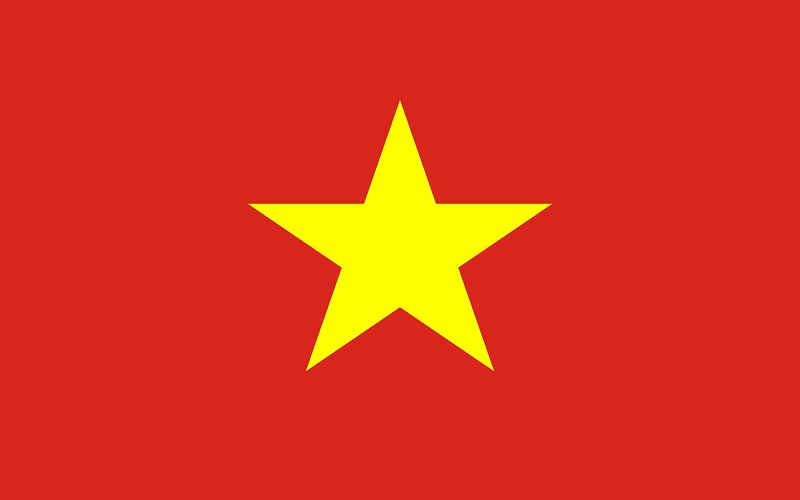Vietnam National & Communist Flags: History and Meaning
Vietnam Flags: Each country in the World has its own national flag, which represents and symbolizes their own country. The national flag is typically designed with specific meanings for its colours and symbols. Visiting Vietnam, tourists usually see 2 different flags: 1- the national flag with the red background and yellow five-pointed star in the centre; 2 – Communist Flag with red colour plus sickle and hammer. The design and color of Vietnam National Flag is very simple but has its own special meanings and has always been the national pride of Vietnamese people.

Vietnam National Flag Today
This article will help you understand more about the history and meaning of Flags in Vietnam with National Flag, Communist Flag, South Vietnam Communist Flag and Republic of South Vietnam Government Flag during the Vietnam War.
1. History of Vietnam National Flag.
Vietnamese National Flag is identified by its people and the World community today predates a unified and independent Vietnam. It first appeared in the Southern Vietnam uprising (Nam Kỳ Khởi Nghĩa) on 23 November 1940, against French Colonialist in Southern Vietnam. The Vietnamese flag was designed by Mr Nguyen Huu Tien (Nguyễn Hữu Tiến), a leader of the uprising who was arrested by the French Colonialist in advance of the failed uprising and executed 28 August 1941.
In 1941, the Flag of Vietnam was displayed at a conference, at which the Viet Minh (a group of Communist) was founded by the Communist Leader Ho Chi Minh to support the locals in the war against the French colonialist government. On 17 August 1945, the Viet Minh Front proclaimed it as the National Flag of Vietnam at the meeting held in the village of Tan Trao in the Northeast of the country.

Vietnamese Communist Government Flag
At the end of World War II, the Japanese surrendered to allies, the Viet Minh entered Hanoi and Ho Chi Minh declared Vietnam independent and the flag became the official emblem of North Vietnam or the Democratic Republic of Vietnam from 02nd September 1945. And later on, 2 September was chosen as Vietnam Independence Day, the day Vietnam was recognized as an independent nation in the world.
Meanwhile, French troops returned in October and restored colonial rules in the South. Under French sponsorship, the South of Vietnam was controlled by Southern Vietnam government, officially called as the Republic of Vietnam and had its own national flag with a yellow background and three horizontal red stripes in the middle.

National Flag of South Vietnam Government (Republic of Vietnam) during the Vietnam War
On March 1946, the National Assembly voted to keep the Viet Minh flag and after the Geneva Accord between France and Vietnam in 1954, the Democratic Republic of Vietnam became the national government. The Vietnamese flag was modified in 1955, making the central star slightly smaller with straighter edges.
After the fall of South Vietnam Gorvernment in 1975, communists people rule the entire country and the government and flag of the South disappeared. Northen Vietnamese Flag was adopted in the South when the two halves of the country were unified as the Socialist Republic of Vietnam on 02 July 1976. And today the red flag with a yellow star is used as National Flag throughout Vietnam.
2. What is the Meaning of Vietnamese Flag?
Vietnamese National Flag of the Socialist Republic of Vietnam is rectangular in shape, its width is equal to two thirds of its length (the proportion is 2:3), in the middle of red background is a bright five-pointed yellow star.

Flag for National Liberation of South Vietnam Communists during the Vietnam War
Vietnamese National Flag meaning and origins can be traced all the way back to the French Revolution of 1789 when a plain red flag became the symbol of left-wing politics. Overtime the symbolism evolved and the basic color scheme was adopted by socialist and then communist causes. Since then, that red core has become a foundation for a number of communist or democratic-socialist nations such as China, North Korea, Macedonia.
Vietnam flag colors include red background and yellow star with special meanings. According to the designer Nguyen Huu Tien, the red background represents blood – a symbol of bloodshed, struggle and the success of revolution, while the yellow foreground represents “the color of our race’s skin”. The five points of the central star stands for the five main classes of the country – farmers, workers, traders, shollars, and military.
On every special national holidays and celebrations such as Reunification Day, Independence Day, Tet Holidays and Traditional Festivals, local people proudly hang their Vietnamese National Flag right at their houses’ entrances. That’s also a meaningful way to remember the Vietnamese soldiers who sacrificed themselves in the wars to protect our country’s peace and independence.
See Also:

![]()
![]()
![]()
![]()
![]()
Best of Vietnam

Best Vietnamese Food You Have to Try in Vietnam
Best Food in Vietnam: Vietnamese Traditional Food is top World well known to be both healthy and...

10 Best National Parks in Vietnam
Vietnam Travel Guide: If you look for the Best Wildlife Discovery Experience in Vietnam, here are...
Read More
Best Souvenir to Buy in Vietnam
If you look for Best Things to Buy when traveling to Vietnam to bring home for your family & friends...
Read More
The 10 Best Places to Visit in Vietnam
Vietnam Travel Guide: Home to an extensive collection of historical and cultural attractions,...
Read More
Top 10 Museums You Should Not Miss in Vietnam
Vietnam, 4.000 years old country has a unique and lengthy history, culture with 54 ethnic groups. It...
Read MoreFind your trip
Vietnam Best Tours
Vietnam Car Rental
Vietnam Travel Blog
- Vietnamese People: Origin, History, Culture and Traditions
- Vietnam Currency: Best ATM and Places to Exchange Money
- Vietnam Map: Regions, Cities & Provinces Map of Vietnam
- What is illegal Things in Vietnam: Rules & Laws for Tourists
- Best Time to Travel to Vietnam to Avoid the Bad Weather
- Vietnam News: Population & Religions of 54 Ethnic Groups









